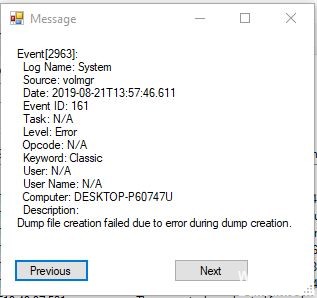
- HOW TO READ A DUMP FILE INSTALL
- HOW TO READ A DUMP FILE MOD
- HOW TO READ A DUMP FILE ARCHIVE
- HOW TO READ A DUMP FILE ZIP
The output of DBMS_DATAPUMP.GET_DUMPFILE_INFO is a bit messy so to do a little formatting we’ll create a procedure name show_dumpfile_info into SYSTEM’s schema this procedure would call DBMS_DATAPUMP.GET_DUMPFILE_INFO itself but then would add a bit of formatting to display the desired result.ĭownload the script to create this show_dumpfile_info procedure from here. Method:2- Using the DBMS_DATAPUMP.GET_DUMPFILE_INFO procedure. So you’ll get the version, datapump or classic export, characterset, OS and other details. Job Name = "ADMIN"."SYS_EXPORT_SCHEMA_01" Output of this script would be something like:-īelow is the formatted header of the dumpfile specified
HOW TO READ A DUMP FILE INSTALL
If perl is not installed, a quick yum -y install perlwould install everything required to run the script. Save the file and save it as (since its a perl script) and run its as:. Method:1- By directly reading the header block with read() system call:. This post is to fetch all these details from the dumpfile.
HOW TO READ A DUMP FILE ARCHIVE
That archive can be unpacked, possibly on another system, into a new, empty directory.Ever got into a scenario where you have a dump file without the logfile and not even sure what was the Oracle database version from where this was exported, the characterset, Operating system and other details of the Source Database ? Or even when you are not aware of which utility was used to export this dump, classic export or expdp ? Or does it contain Full DB dump or schema dump or table dumps ?
HOW TO READ A DUMP FILE ZIP
One way to assist jdmpview to locate those files is by specifying on the command line one or both of the path mapping option ( .mapping=) and the library path option ( .path=).Īlternatively, on the system where the core file was produced, you can use jpackcore to collect all the relevant files into a single zip archive.

HOW TO READ A DUMP FILE MOD
Therefore, first check the executable and the list of native libraries by running jdmpview on a core with the info mod command. However, if the executable and the libraries are in their original locations, jdmpview might not consider them. For example, commands that relate to call-sites.Ī common scenario involves using jdmpview to examine core files that originate on different systems. Note: On AIX and Linux, some jdmpview commands must locate the executable and the native libraries that are referenced by the core. With these options, jdmpview shows multiple contexts, one for each source file that it identified in the compressed file. Note: The -core option can be used with the -zip option to specify the core file in the compressed file. The variable is a list of paths to search for native libraries, using the usual path separator (a semi-colon (' ') on Windows, and a colon (':') on other platforms). The variable is a list of native library mappings of the form old-path=new-path, using the usual path separator (a semi-colon (' ') on Windows, and a colon (':') on other platforms). Use the -notemp option to prevent this extraction step, and run all subsequent commands in memory. Specifies a compressed file containing the core file (produced by the dump extractor ( jpackcore) tool on AIX®, Linux®, and macOS® systems).īy default, when you specify a file by using the -zip option, the contents are extracted to a temporary directory before processing.


For problems like general protection faults (GPFs), system abends, and SIGSEGVs, a system debugger such as gdb (Linux) provides more information. The dump viewer is useful for diagnosing OutOfMemoryError exceptions in Java™ applications.

You can run the dump viewer on one platform to work with dumps from another platform.įor long running tasks, the dump viewer can also be run in batch mode. The dump viewer allows you to view both Java™ and native information from the time the dump was produced. The dump viewer is a command-line tool that allows you to examine the contents of system dumps produced from the OpenJ9 VM. XX:OriginalJDK8HeapSizeCompatibilityMode


 0 kommentar(er)
0 kommentar(er)
